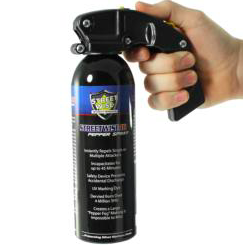Police use of force has recently stirred widespread public interest and concern. Recent use of force incidents have been well-publicized on social media due to the ability of the public to witness and video record police actions. However, owing to the fact that the operations of jails and prisons are hidden from public view, little is known about use of force in jails and prisons, particularly about uses of less than lethal force that do not generate attention.
In November 2015 I was afforded the opportunity to tour the Dane County Jail System. The Dane County Jail System is situated in Madison (WI) and comprises three jail facilities that hold inmates in maximum, medium, and minimum security. The jail system has capacity for approximately 1,000 inmates.

I was shown an equipment room that had a row of gas masks hanging up in it. I was informed they were for staff to wear when they “fogged” inmates. “Fogging” is a type of pepper spray delivery method. The active agents in pepper spray are derived from hot peppers, and pepper spray: “inflames the tissues. It burns the eyes, the throat, the skin. It frequently causes temporary blindness as the eyes dilate. It makes breathing difficult… Depending on how much you are hit with, it lasts at least 30 to 45 minutes, sometimes as much as four hours…. It makes the skin—people describe it as it feels like your skin is burning off” (Coleman v. Brown).
Different from pepper spray that police may carry with them that has a “stream” deployment method, this type of pepper spray is like an aerosol, with fine droplets of pepper spray. It is contained in a canister that looks like a small fire extinguisher (see photo). Pepper spray that is deployed using a fogger attachment is more widely dispersed in the air than pepper spray that is deployed using the stream method. I was informed by a staff member at the jail system that sometimes, if you are unaware that someone has been “fogged” on a jail floor, the first indicator will be that will be able to smell it and your senses will feel mildly irritated.

I recently spoke to Sheriff Mahoney, the Dane County sheriff, to find out more about use of pepper spray in the jail system. He informed me that it is used a couple of times a year, and less than once a month, perhaps indicating that it is used approximately 2-6 times a year. However, he stated that frequency of use is dependent on the conduct of inmates is in the jail, which fluctuates over time. It is usually used against inmates in maximum security, however staff have the equipment available to use in medium security too.
It may be used in situations where there is a physical confrontation, or in situations where the inmate may have “barricaded” themselves in their cell. Sheriff Mahoney cited examples such as if staff need to move an inmate who has either put their mattress up against their cell door or crawled under their bed. In accordance with Wisconsin State statutes (Department of Corrections, chapter 306.09) staff may use “incapacitating agents” against inmates, defined as any “agent or device commercially manufactured and approved by the department for the purpose of temporary control of an inmate or area”. The statute allows for a wide interpretation of when such force may be used:
“Staff may use incapacitating agents in any of the following situations:
(a) To prevent death or bodily injury to oneself or another.
(b) To regain control of an institution or part of an institution.
(c) To prevent escape or apprehend an escapee.
(d) To change the location of an inmate.
(e) To control a disruptive inmate.
(f) To prevent unlawful damage to property.
(g) To enforce a departmental rule, policy or procedure or an order of a staff member.”
The Sheriff advised me that if they believe that “fogging” an inmate is necessary, an “entry team” dressed in protective clothing, and wearing a helmet and gas mask, will enter the area to do the deployment. Human Rights Watch described a similar scenario in the class action case Coleman v. Brown (2014): “a cell extraction team assembled… wearing gas masks, suited head to toe in biohazard suits, and armed with handcuffs, leg irons, batons, a full-length plastic body shield, and fire-extinguisher-sized canisters of pepper spray.”
To my knowledge, there is no information about the use of pepper spray in jails or prisons in Wisconsin. However, uses of pepper spray and/or tear gas have been documented in 21 other states (https://www.warresisters.org/facing-tear-gas-prison). Even if cases have been documented, there is little information on how common the use of pepper spray is nationally. To further complicate matters, there may be differences in whether pepper spray is more likely to be used against inmates with mental illness compared to inmates without mental illness. Human Rights Watch reported that in Colorado between March 2013 and February 2014 “cell extractions involving pepper spray occurred at a rate of 44.4 per 1,000 inmates with mental illness compared to 3.8 per 1,000 other inmates.”
Research is needed on the prevalence of “fogging” and other forms of pepper spraying, as well as other types of less then lethal force, in both jails and prisons. Numerous questions need to be explored. For example, how common is this nationally? Is this more likely to occur in jails or prisons? Is this force being disproportionately used against people with mental illness? The public deserves to be better informed about the types of uses of force that occur beyond the public gaze.
Emma Frankham is a Sociology PhD student at UW-Madison. Comments or queries about this blog post are welcome below, or at frankham@wisc.edu.
References
Administrative Code, Department of Corrections, Chapter 306. http://docs.legis.wisconsin.gov/code/admin_code/doc/306/07
Coleman v. Brown, United States District Court for the Eastern District of California, case no. 2:90-cv-00520, Defendants’ Plans and Policies Submitted in Response to April 10, 2014 and May 13, 2014 Orders, Coleman v. Brown, filed August 1, 2014, p. 5.
Human Rights Watch (2015) Callous and Cruel: Use of Force against Inmates with Mental Disabilities in US Jails and Prisons https://www.hrw.org/report/2015/05/12/callous-and-cruel/use-force-against-inmates-mental-disabilities-us-jails-and


My Son is serving time at Mcdowell County Correctional Center now. He said that sbout 50 inmates has been wading water over there ankles and bedclothes and clothes are soaked. They kept complaining about this when the athoraties came in spraying tear gas & pepper spray on the inmates. There is quite a few immates that has not been decomtanmated yet from the same clothing and has not been allowed a shower or clean clothes they have been like this for over 36 hours. This is crazy that spray can irrtate there skin cause problemd breathing and more problems and still hsve the smell from the srayes on the clothes they are made to continute to wear as long as over 36 hourd. This is ridulas yes they are prisoners but they also are human beings
They have some rights still as prisoners. This stuff can blind a person for good for the rest of there lifes. Something needs to be done about this. My understanding is that the states are over all prisons but a very fee. From what I have heard there are 103 prisons in WV and all of them are run by the state except fir Mcdowell County prisons. And one of the prisons there is a Federal Prison. Why would the state of WV be over every other prison in WV but that one its run by the County. And Im. Sure that Mcdowell Federal Prison is not run by the County. Why cant the state run this prison which is called Stevens Correctional Center. Like they are over all other prisons in this state of WV. They get treated poorly and they are trasferring prisoners from other WV prisons to Stevens Correctional Center after all states have been told no trasferring prisoners are allowed at this time due to the conan virus. Could someone explain to me how this is allowed?